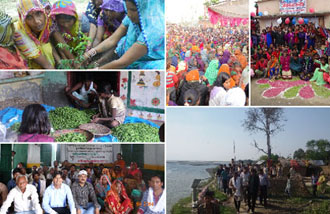APARAJITA SAMAJIK SAMITI
Child Marriage Free India

Aparajita Samajik Samiti, founded in 2000, is a non-governmental, non-political, and secular organization dedicated to promoting social justice and empowerment, particularly focusing on the rural poor, with an emphasis on women and children. Registered under the Societies Registration Act (1860) and the Foreign Contribution (Regulation) Act, Aparajita aims to enable women through various initiatives.
Initially centered on attaining social justice and equality for women, Aparajita engaged in activities such as campaigns, rallies, and interactions with government officials to raise awareness about women's rights and entitlements. Over time, the organization recognized the need for a holistic development approach and expanded its focus areas to include agriculture and livestock-based livelihood promotion among the rural poor, education for girl children, and water sanitation and hygiene.
Aparajita's development approach revolves around empowering women by enhancing their participation in socio-economic activities, equipping them with technical and managerial skills, and educating them about their rights and entitlements. This approach aims to enable women to actively engage in developmental processes.
The organization has partnered with the Kailash Satyarthi Children Foundation to implement the "Access to Justice" program in five blocks of District Gonda since 2023. The program's objective is to make Gonda free from child marriage, child labor, trafficking, and child sexual abuse through advocacy with line departments, collaboration with stakeholders, and awareness-raising activities at the district, block, Panchayat, and school levels. The five blocks covered by the program include Jhanjhari, Belsar, Colonelganj, Paraspur, and Haldharmau.
Background
Child marriage is not just an age-old social evil, but also a heinous crime that robs children of their childhood. Child marriage is a “crime against children” that violates basic human rights, minor girls are forced to marry and live a life of mental trauma, physical and biological stress, domestic violence including limited access to education, and increased vulnerability to domestic violence. The consequences of child marriage are severe and extensive. Some of the specific consequences include early pregnancies leading to complications and a higher rate of maternal mortality and death of infants, malnutrition among both the infant and the mother, increased vulnerability to reproductive health, disruption in girl’s education, and thereby reduction in opportunities of her personal and professional development, domestic violence and abuse, limited decision-making powers in the household, and mental health issues.
India’s Census 2011 revealed that 12 million children were married before attaining the legal age, of which 5.2 million were girls. Globally, child marriage is identified as a crime and a menace that needs to be eliminated. It finds space in the UN Sustainable Development Goals, under target 5.3 of Goal 5 which states the elimination of all harmful practices, such as child, early and forced marriage, and female genital mutilation by 2025.
The latest National Family Health Survey (2019-21) shows that although there is a drop in the overall rate of child marriages, from 26.8% in the National Family Health Survey (NFHS 4) to 23.3% in NFHS-5, it is still high despite laws, programs, and schemes in place to address the issue.
Child Marriage Free India Campaign
Understanding the seriousness of the issue, the Hon'ble Supreme Court of India in W.P. Civil 382 of 2013 pronounced that the sexual intercourse committed by the husband upon his wife being under the age of 18 years with or without her consent can be constituted as rape. To address this, the most definitive and audacious commitment to end child marriage was made with the launch of the Child Marriage Free India campaign.
Child Marriage Free India (CMFI) is a nationwide campaign led by women leaders and a coalition of more than 160 NGOs spanning more than 300 districts working to eliminate child marriage in India. CMFI is working to attain the tipping point of child marriage, after which society does not accept this evil practice, and that will happen when the prevalence of child marriage is brought down to 5.5% by 2030, from the current national prevalence rate of 23.3%. This is being done by initially targeting 257 high-prevalence districts and gradually focusing on all the districts of the country.
Child marriage results in child rape, resulting in child pregnancy, and in a large number of cases, may lead to child deaths. For decades, we have been losing generations of our children to child marriage. The Child Marriage Free India campaign has received extended support from various Departments and Institutions of over 28 States. So far, across India more than 5 crore people have taken the pledge to end child marriage over the last year through the efforts of the Child Marriage Free India Campaign.
Know more about the Child Marriage Free India (CMFI) Campaign: https://www.childmarriagefreeindia.org/

The Way Forward: PICKET Strategy to End Child Marriage
Addressing the issue of child marriage, requires a comprehensive and coordinated approach of different government departments, institutions, statutory bodies, and civil society organisations.

Tipping Point to end child marriage
WHEN CHILDREN HAVE CHILDREN - TIPPING POINT TO END CHILD MARRIAGE Book authored by Mr Bhuwan Ribhu is an action plan to eliminate child marriage in India by 2030. It looks at the existing data on child marriage and lists 257 districts in India where the issue of child marriage is worst, which means where the occurrence of this evil practice is highest as compared to national numbers.
Tipping Point is the threshold required in an ecosystem needed to tilt the scale of the problem towards a point of no-return. The Tipping Point of Child Marriage is the critical point after which the society does not accept child marriage.
Tipping Point Methodology
The aim of reduction of 60 percent of child marriage is assumed to bring down the incidence of child marriage to 5.5 percent in the next nine years from 2021, from the last available estimates i.e., NFHS-5, till 2030. An additional assumption is that such a focused and elaborate intervention against child marriage would have a ripple effect.
In order to reach the Tipping Point, the Author proposes strategy at national and district level.
- National Level strategy where Governments, Institutions, statutory bodies, etc. work towards prevention, protection, increased investment, improved prosecution, convergence and use of technology for monitoring
- District Level strategy is similar to national level strategy but includes district administration, Panchayats, civil society, NGOs, other functionaries, parents and children who work collectively to prevent, report, and take action against child marriage

Case Study – Preventing Child Marriage:
"Empowering Girls: A Story of Overcoming Child Marriage"
My name is Babita, and I am 17 years old. I have studied up to class 10. I have three siblings, and my father works as a laborer. Despite our financial struggles, my father managed to educate me until the 10th grade. I wanted to continue my studies further, but due to the distance of the school from our home and concerns within my family about potential risks, I couldn't pursue education beyond that. Instead, I started helping with household chores.
My father arranged my marriage, believing it was time for me to settle down. He told me not to think about studying anymore and to focus on managing a household after marriage. However, recently, I heard some people discussing that marrying a girl before the age of 18 and a boy before the age of 21 is illegal and detrimental to physical development.
One day, I came across some people distributing pamphlets discussing the adverse effects of child marriage. I brought one home and read it to my father. He asked who these people were and suggested meeting them.
Soon after, members of Aparajita Samajik Samiti visited our home upon learning about the impending marriage discussions. They explained their work and the harms of child marriage. After this discussion, my father opened up about his plans for my marriage this year.
However, after being enlightened by the information provided by Aparajita Samajik Samiti, my family decided to delay my marriage until I turned 18. They also pledged to support my education, and when my name is enrolled this year, it will be for school, not marriage.
I am grateful to Aparajita Samajik Samiti for their help. Now, I can pursue my studies and continue to raise awareness to stop child marriages.

